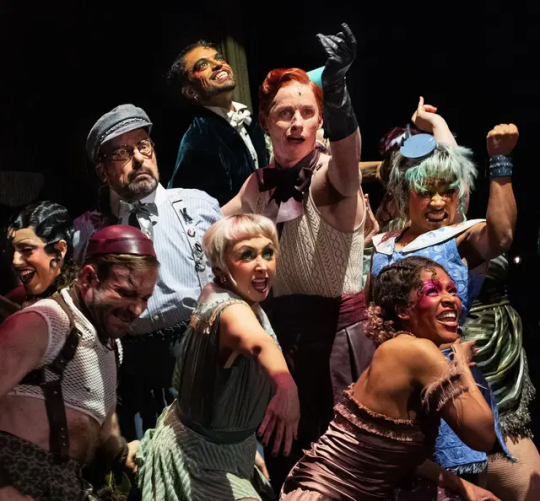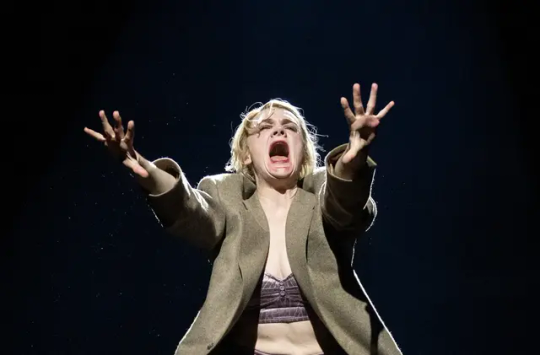#cabaret nwe production
Text
‘Cabaret’ Review: What Good Is Screaming Alone in Your Room?
Eddie Redmayne and Gayle Rankin star in a buzzy Broadway revival that rips the skin off the 1966 musical.

Eddie Redmayne, center, as the Emcee in Rebecca Frecknall’s revival of “Cabaret” at the August Wilson Theater in Manhattan.Credit...Sara Krulwich/The New York Time
By Jesse Green April 21, 2024
Just east of its marquee, the August Wilson Theater abuts an alley you probably didn’t notice when last you were there, perhaps to see “Funny Girl,” its previous tenant. Why would you? Where the trash goes is not usually part of the Broadway experience.
But it is for the latest revival of “Cabaret,” which opened at the Wilson on Sunday. Audience members are herded into that alley, past the garbage, down some halls, up some stairs and through a fringed curtain to a dimly lit lounge. (There’s a separate entrance for those with mobility issues.) Along the way, greeters offer free shots of cherry schnapps that taste, I’m reliably told, like cough syrup cut with paint thinner.
Too often I thought the same of the show itself.
But the show comes later. First, starting 75 minutes beforehand, you can experience the ambience of the various bars that constitute the so-called Kit Kat Club, branded in honor of the fictional Berlin cabaret where much of the musical takes place. Also meant to get you in the mood for a story set mostly in 1930, on the edge of economic and spiritual disaster, are some moody George Grosz-like paintings commissioned from Jonathan Lyndon Chase. (One is called “Dancing, Holiday Before Doom.”) The $9 thimbleful of potato chips is presumably a nod to the period’s hyperinflation.
This all seemed like throat clearing to me, as did the complete reconfiguration of the auditorium itself, which is now arranged like a large supper club or a small stadium. (The scenic, costume and theater design are the jaw-dropping work of Tom Scutt.) The only relevant purpose I can see for this conceptual doodling, however well carried out, is to give the fifth Broadway incarnation of the 1966 show a distinctive profile. It certainly does that.
The problem for me is that “Cabaret” has a distinctive profile already. The extreme one offered here frequently defaces it.
Let me quickly add that Rebecca Frecknall’s production, first seen in London, has many fine and entertaining moments. Some feature its West End star Eddie Redmayne, as the macabre emcee of the Kit Kat Club (and quite likely your nightmares). Some come from its new New York cast, including Gayle Rankin (as the decadent would-be chanteuse Sally Bowles) and Bebe Neuwirth and Steven Skybell (dignified and wrenching as an older couple). Others arise from Frecknall’s staging itself, which is spectacular when in additive mode, illuminating the classic score by John Kander and Fred Ebb, and the amazingly sturdy book by Joe Masteroff.

In this production, Gayle Rankin’s Sally Bowles is meant to be taken medicinally and poisonously, projecting instead of concealing her character’s turmoil, our critic writes.Credit...Sara Krulwich/The New York Times
But too often a misguided attempt to resuscitate the show breaks its ribs.
The conception of Sally is especially alarming. As written — and as introduced in the play and stories the musical is based on — she is a creature of blithe insouciance if not talent, an English good-time gal flitting from brute to brute in Berlin while hoping to become a star. Her first number, “Don’t Tell Mama,” is a lively Charleston with winking lyrics (“You can tell my brother, that ain’t grim/Cause if he squeals on me I’ll squeal on him”) that make the Kit Kat Club audience, and the Broadway one too, complicit in her naughtiness.
Instead, Frecknall gives us a Sally made up to look like she’s recently been assaulted or released from an asylum, who dances like a wounded bird, stretches each syllable to the breaking point and shrieks the song instead of singing it. (Goodbye, Charleston; hello, dirge.) If Rankin doesn’t sound good in the number, nor later in “Mein Herr,” interpolated from the 1972 film, she’s not trying to. Like the cough syrup-paint thinner concoction, she’s meant to be taken medicinally and poisonously in this production, projecting instead of concealing Sally’s turmoil.
That’s inside-out. The point of Sally, and of “Cabaret” more generally, is to dramatize the danger of disengagement from reality, not to fetishize it.
The guts-first problem also distorts Redmayne’s Emcee, but at least that character was always intended as allegorical. He is the host to anything, the amoral shape-shifter, becoming whatever he must to get by. Here, he begins as a kind of marionette in a leather skirt and tiny party hat, hiccupping his way through “Willkommen.” Later he effectively incarnates himself as a creepy clown, an undead skeleton, Sally’s twin and a glossy Nazi.
Having seen Frecknall’s riveting production of “Sanctuary City,” a play about undocumented immigrants by Martyna Majok, I’m not surprised that her “Cabaret” finds a surer footing in the “book” scenes. These are the ones that take place in the real Berlin, not the metaphorical one of the Kit Kat Club. She is extraordinarily good when she starts with the naturalistic surface of behavior, letting the mise en scène and the lighting (excellent, by Isabella Byrd) suggest the rest.
And naturalism is what you find at the boardinghouse run by Fräulein Schneider (Neuwirth), a woman who has learned to keep her nose down to keep safe. Her tenants include a Jewish fruiterer, Herr Schultz (Skybell); a prostitute, Fräulein Kost (Natascia Diaz); and Clifford Bradshaw (Ato Blankson-Wood), an American writer come to Berlin in search of inspiration. Soon Sally shows up to provide it, having talked her way into Cliff’s life and bed despite being little more than a stranger. Also, despite Cliff’s romantic ambivalence; over the years, the character has had his sexuality revamped more times than a clownfish.
The Schneider-Shultz romance is sweet and sad; neither character is called upon to shriek. And Rankin excels in Sally’s scenes with Cliff, her wry, frank and hopeful personality back in place. The songs that emerge from the boardinghouse dramas are not ransacked as psychiatric case studies but are rather given room to let comment proceed naturally from real entertainment. Rankin’s “Maybe This Time,” with no slathered-on histrionics, is riveting. It turns out she can properly sing.

The interface between the naturalism and the expressionism does make for some weird moments: Herr Schultz, courtly in a topcoat, must hug Sally goodbye in her bra. But letting the styles mix also brings out the production’s most haunting imagery. The intrusion of the Nazi threat into the story is especially well handled: first a gorgeously sung and thus chilling version of “Tomorrow Belongs to Me,” then the swastika and then — well, I don’t want to give away how Frecknall stages the scene in which Schultz’s fruit shop is vandalized.
That so many of these moments arise from faithful attention to the original material should be no surprise. “Cabaret” hasn’t lasted this long for nothing. Created at the tail end of Broadway’s Golden Age, it benefited from the tradition of meticulous craftsmanship that preceded it while anticipating the era of conceptual stagings that followed.
All this is baked into the book, and especially the score, which I trust I admire not merely because I worked on a Kander and Ebb show 40 years ago. That the lyrics rhyme perfectly is a given with Ebb; more important, they are always the right words to rhyme. (Listen, in the title song, for the widely spaced triplet of “room,” “broom” and, uh-oh, “tomb.”) And Kander’s music, remixing period jazz, Kurt Weill and Broadway exuberance, never oversteps the milieu or outpaces the characters even as it pushes them toward their full and sometimes manic expression.
When this new “Cabaret” follows that template, it achieves more than the buzz of chic architecture and louche dancing. (The choreography is by Julia Cheng.) Seducing us and then repelling us — in that order — it dramatizes why we flock to such things in the first place, whether at the Kit Kat Club or the August Wilson Theater. We hope, at our risk, to forget that, outside, “life is disappointing,” as the Emcee tells us. We want to unsee the trash.
Cabaret
At the August Wilson Theater, Manhattan; kitkat.club. Running time: 2 hours 45 minutes, with an optional preshow.
Jesse Green is the chief theater critic for The Times. He writes reviews of Broadway, Off Broadway, Off Off Broadway, regional and sometimes international productions. More about Jesse Green
https://www.nytimes.com/2024/04/21/theater/cabaret-review-eddie-redmayne.html
#eddie redmayne#cabaret#cabaret nyc#review new york times#broadway#eddie redmayne cabaret#cabaret nwe production#august wilson#theatre#cabaret 2024#musical#cabaret musical
10 notes
·
View notes